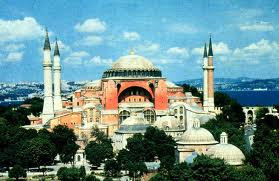Hagia Sophia is a former Orthodox patriarchal basilica, later a mosque, and now a museum in Istanbul, Turkey. From the date of its dedication in 360 until 1453, it served as the cathedral of Constantinople, except between 1204 and 1261, when it was converted to a Roman Catholic cathedral under the Latin Patriarch of Constantinople of the Western Crusader established Latin Empire. The building was a mosque from 29 May 1453 until 1931, when it was secularized.It was opened as a museum on 1 February 1935.
The Church was dedicated to the Logos, the second person of the Holy Trinity, its dedication feast taking place on December 25, the anniversary of the incarnation of the Logos in Christ. Although it is sometimes referred to as Sancta Sophia , sophia is the phonetic spelling in Latin of the Greek word for wisdom - the full name in Greek being "Church of the Holy Wisdom of God".
Architecture
Hagia Sophia is one of the greatest surviving examples of Byzantine architecture. Of great artistic value was its decorated interior with mosaics and marble pillars and coverings. The temple itself was so richly and artistically decorated that Justinian proclaimed, "Solomon, I have outdone thee!" . Justinian himself had overseen the completion of the greatest cathedral ever built up to that time, and it was to remain the largest cathedral for 1,000 years up until the completion of the cathedral in Seville in Spain. At the western entrance and eastern liturgical side, the arched openings are extended by half domes carried on smaller semi-domed exedras; a hierarchy of dome-headed elements built up to create a vast oblong interior, crowned by the main dome. Despite all of the aforementioned features, the weight of the dome remained a problem, requiring the addition of external buttresses.Interior surfaces are sheathed with polychrome marbles, green and white with purple porphyry, and gold mosaics.
Dome
The dome of Hagia Sophia has spurred particular interest for many art historians, architects and engineers because of the innovative way the original architects envisioned the dome. The dome is supported by pendentives which had never been used before the building of this structure. The pendentive enables the dome to transition gracefully into the square shape of the piers below. The pendentives not only achieve a pleasing aesthetic quality, but they also restrain the lateral forces of the dome and allow the weight of the dome to flow downward. Although this design stabilizes the dome and the surrounding walls and arches, the actual construction of the walls of Hagia Sophia weakened the overall structure. The bricklayers used more mortar than brick, which weakened the walls. The structure would have been more stable if the builders at least let the mortar cure before they began the next layer; however, they did not do this. When the dome was placed atop the building, the weight of the dome caused the walls to lean outward because of the wet mortar underneath. When Isidorus the Younger rebuilt the original dome, he had to first build up the interior of the walls so that they were vertical in order to support the weight of the new dome. Another probable change in the design of the dome when it was rebuilt was the actual height of the dome. Isidore the Younger raised the height of the dome by approximately six metres so that the lateral forces would not be as strong and the weight of the dome would flow more easily down the walls.
Mosaics
The church was richly decorated with mosaics throughout the centuries. They either depicted the Virgin Mother, Jesus, saints, or emperors and empresses. Other parts were decorated in a purely decorative style with geometric patterns. During the Sack of Constantinople in 1204, the Latin Crusaders vandalized valuable items in every important Byzantine structure of the city, including the golden mosaics of the Hagia Sophia. Many of these items were shipped to Venice, whose Doge, Enrico Dandolo, had organized the invasion and sack of Constantinople.
20th-century restoration
A large number of mosaics were uncovered in the 1930s by a team from the Byzantine Institute of America led by Thomas Whittemore. The team chose to let a number of simple cross images remain covered by plaster, but uncovered all major mosaics found. Because of its long history as both a church and a mosque, a particular challenge arises in the restoration process. The Christian iconographic mosaics are being gradually uncovered. However, in order to do so, important, historic Islamic art would have to be destroyed. Restorers have attempted to maintain a balance between both Christian and Islamic cultures. In particular, much controversy rests upon whether the Islamic calligraphy on the dome of the cathedral should be removed, in order to permit the underlying Pantocrator mosaic of Christ as Master of the World, to be exhibited (assuming the mosaic still exists







No comments:
Post a Comment